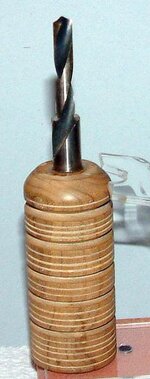To answer several questions...
It did a very nice job on the ends of my last pen after I put a nice CA glue finish on between centers. Didn't chip it up like the pen mills tend to do...
Why are you using a pen mill (or anything) after applying CA finish ?



For me, when using the mandrel, breaking the edge between the CA'ed blank and bushing sometimes caused the CA to break unevenly. I used a sander penmill to even it up. I did use a knife to cut the excess off but the sandermill did it more evenly and smoothly. So, why not use a mill?
After I went to TBC some years ago and started finishing without bushings, the CA would still overflow the ends. Again, I continued to use a sanding pen mill to get the excess CA off the ends and smooth the ends to the brass/blank. I will add that after I use the sander mill to get the excess CA off of the ends of the tubes, I put the blank back on the lathe TBC and smooth/polish the edges up.
I don't see anything abnormal about this to cause confusion.
.
My only 'issue' with this is .... why use anything as aggressive as a mill after finishing? Just seems counter productive. . . . .
This (now off topic) subject of how to remove excess CA has as many answers as there are members of this forum. We can all learn from others experience.
It may be just me but your statements come across as contradictory. . . "has as many answers" - vs - "anything as aggressive as a "mill' ".
Maybe you don't understand or know what a
sanding pen mill is. It certainly is NOT aggressive. And, while hand squaring the excess by hand and a jewelers file can be as square/accurate (in the right hands) as a sanding pen mill, it is not MORE accurate. Remember, we are talking about excess CA that still needs to be squared. That is where a squared sander with 400 grit is exellent and leaves nothing to chance.
If you have the perfect hand touch, that is great. One thing I have learned on this forum over the years is that not everyone has the same talent and skills. What some can do by hand (as apparently you can), other can barely achieve the same with the most accurate of tools. Jewelers files are fine and on occasion, I will touch one up with that. However, for many people without your skill set, squaring excess is better accomplished with a non-aggressive 400ish SP on a squared sander of one kind or other.

